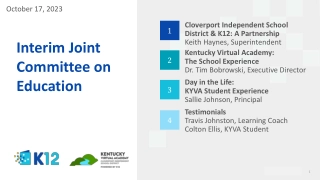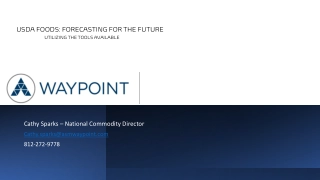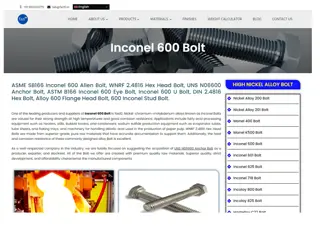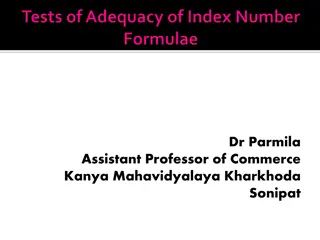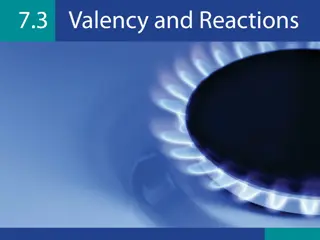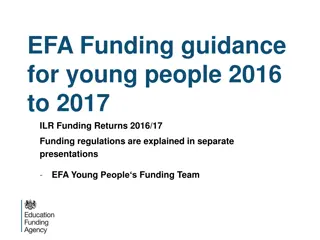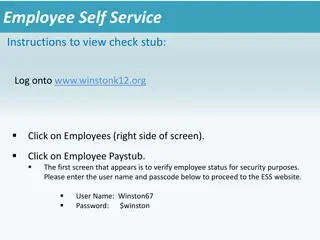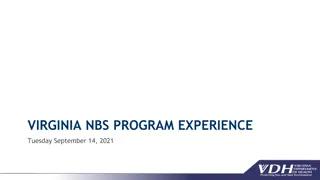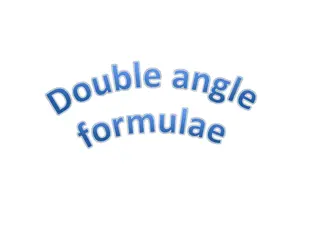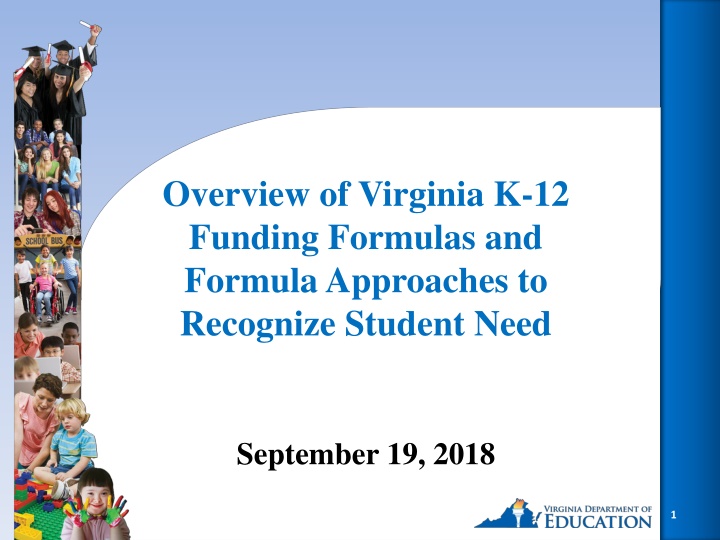
Mechanics of Virginia K-12 Funding Formulas & Student Need Recognition
"Explore the mechanics of Virginia K-12 funding formulas, key input variables, and approaches to recognize student needs. Discover how free lunch rates and test scores play a role in funding programs aimed at supporting at-risk students and enhancing educational outcomes." (Approximately 500 characters)
Download Presentation

Please find below an Image/Link to download the presentation.
The content on the website is provided AS IS for your information and personal use only. It may not be sold, licensed, or shared on other websites without obtaining consent from the author. If you encounter any issues during the download, it is possible that the publisher has removed the file from their server.
You are allowed to download the files provided on this website for personal or commercial use, subject to the condition that they are used lawfully. All files are the property of their respective owners.
The content on the website is provided AS IS for your information and personal use only. It may not be sold, licensed, or shared on other websites without obtaining consent from the author.
E N D
Presentation Transcript
Overview of Virginia K-12 Funding Formulas and Formula Approaches to Recognize Student Need September 19, 2018 1
Presentation Overview Provide an overview of the mechanics of state K-12 (Direct Aid) funding formulas, including key inputs used in the formulas Present formula approaches to recognize student need 2
Presentation Topics Key Input Variables Used in Direct Aid Funding Formulas Direct Aid Funding Categories State and Local Shares of Funding Formula Approaches to Recognize Student Need Appendices 3
Key Input Variables Used in Direct Aid Funding Formulas 4
Free Lunch Rates Division-wide and school-level free lunch rates (FL%) are provided annually through the National School Lunch Program. Free lunch data are used in five Direct Aid formulas targeting at-risk students. Data is updated biennially in the formulas. 5
Direct Aid Programs using FL% Program FY19 Appropriation SOQ PIR (Prevention, Intervention, & Remediation)* $113.1 million At-Risk Add-on $100.3 million K-3 Class Size Reduction** $130.6 million SOL Algebra Readiness $13.0 million Virginia Preschool Initiative $75.3 million Total $432.2 million *SOQ Remedial Education uses a 3-year average of division-level free lunch data. **K-3 Class Size Reduction uses a 3-year average of school-level free lunch data. 6
Test Scores Test or assessment scores are used in several Direct Aid formula calculations. Tests include: Standards of Learning (SOLs) PALS Diagnostic (K-3) 7
Direct Aid Programs using Test Scores Program SOQ PIR (uses division 3-yr. avg. failure rates for English and math SOL tests) Early Reading Specialists (uses 3rd Grade reading SOLs) Math/Reading Specialists (uses math or reading SOLs, all grades) Early Reading Intervention (uses K-3 PALS) Project Graduation (uses HS math, reading/writing, science, and history SOLs) FY19 Appropriation $113.1 million $1.8 million $1.5 million $22.6 million $1.4 million Total $140.4 million 8
Enrollment Direct Aid funds are distributed based upon two different enrollment counts: Sept. 30th Fall Membership (FM) March 31 Average Daily Membership (ADM) Most state funding distributed using ADM; provided in division-level allocations. 9
Large Direct Aid Programs using FM Program FY19 Appropriation English as a Second Language (SOQ)* $62.2 million Early Reading Intervention $22.6 million K-3 Class Size Reduction $130.6 million SOL Algebra Readiness $13.0 million Virginia Preschool Initiative** $75.3 million Total $303.7 million *English language learner counts from Fall SRC. **VPI slots are computed based on a fall membership projection of kindergarten. 10
Large Direct Aid Programs using ADM Program Standards of Quality (all accounts)* At-Risk Add-on Supplemental Lottery Per Pupil Allocation Funding FY19 Appropriation $4.7 billion $100.3 million $234.7 million Total $5.0 billion *These Standards of Quality accounts include: Basic Aid; Textbooks; Career & Technical Education; Gifted Education; Special Education; Prevention, Intervention, and Remediation (PIR); VRS Retirement; Social Security; and Group Life. 11
Direct Aid Budget State funding (GF & NGF) is appropriated in the Direct Aid budget in four major service areas : Standards of Quality ($6.2 billion) Incentive Programs ($158.1 million) Categorical Programs ($58.9 million) Lottery Proceeds Fund ($592.5 million) FY19 Direct Aid Funding SOQ = 88.4% SOQ Incentive Categorical Lottery 13
Standards of Quality FY19 funding for the Standards of Quality is provided through the following accounts, mostly on a per pupil basis: Basic Aid ($3.3 billion) Special Education ($397.7 million) Career and Technical Education ($58.4 million) Prevention, Intervention, & Remediation (PIR) ($113.1 million) Gifted Education ($35.4 million) English as a Second Language ($62.2 million) Fringe Benefits for funded instructional pos. ($657.4 million) Sales Tax ($1.4 billion) Remedial Summer School ($24.9 million) Textbooks ($70.3 million) Early Reading Intervention and Algebra Readiness (are SOQ but Lottery-funded) 14
SOQ Funding Process General Concept Staffing Standards Required Positions State Share (55% on avg.) Per Pupil Cost of Required Positions Calculation Specific Data Inputs (ex. funded salaries) Total Program Cost LCI Base Year Enrollment Local Share (45% on avg.) Actual Enrollment 15
Example SOQ Program: PIR Staffing Standards: Sliding scale pupil:teacher ratios from 10:1 to 18:1 based on SOL failure rates; 1.0 additional instruction hour per day State Share (55% on avg.) Inputs: Free Lunch SOL Scores Fall Memb. Salaries Per Pupil Cost of Required Positions Calculation Total Program Cost LCI Base Year March 31 ADM Actual March 31 ADM Local Share (45% on avg.) 16
SOQ Program Basic Aid Basic Aid Details Historical State Funding Year Funding Purpose To support the cost of basic school division operations FY20* $3.3 billion* FY19* $3.3 billion* Requirements to Receive Funds Unique Inputs Mandatory must meet staffing standards FY18 $3.2 billion FY17 $3.2 billion FY16 $3.1 billion staffing standards, support positions (salaries and benefits), sales tax, support costs, inflation rates funded salaries, base year ADM, cost of competing adj. (COCA) for No. Va. Required based on LCI *Based on Chapter 2 budget. Other Inputs St./Local Match 17
SOQ Program Special Education Special Education Details Historical State Funding Year Funding Purpose To provide the state share of the cost of required special education instructors Mandatory must meet staffing standards FY20* $398.5 million* FY19* $397.7 million* Requirements to Receive Funds Unique Inputs FY18 $382.4 million FY17 $382.3 million FY16 $368.1 million December 1 spec. ed. child count, case load standards *Based on Chapter 2 budget. Other Inputs Funded salaries, Base Year ADM, COCA St./Local Match Required based on LCI 18
Incentive Programs Incentive Programs are voluntary but require additional conditions to receive state funding; some local matches. FY19 Incentive Programs and state funding: Compensation Supplement ($0.0 million funded in FY20) Governor s School ($17.8 million) At-Risk Add-on ($100.3 million) Math/Reading Instructional Specialists ($1.8 million) Early Reading Specialists Initiative ($1.4 million) Small School Division Enrollment Loss ($6.1 million FY19 only) Spec. Ed. Regional Tuition GF portion ($28.0 million) Other programs ($2.6 million) 19
Incentive Program Compensation Supplement Compensation Supplement Details Historical State Funding Year Funding Purpose To provide the state share of a salary increase for funded SOQ instructional and support positions Certification that the compensation supplement is provided to required staff Salary increase rate & eff. date of raise, funded positions ADM FY20* $130.3 million* FY19* $0.0 million* FY18 $31.7 million Requirements FY17 $0.0 million FY16 $51.8 million Unique Inputs *Based on Chapter 2 budget. Other Inputs Match Formula match not required in Chapter 2 budget 20
Incentive Program At-Risk Add-on At-Risk Add-on Details Historical State Funding Year Funding Purpose An additional state payment in support of educationally at- risk students Certification of available local match, permitted uses of funds Min./Max. per pupil add-on percentages (on sliding scale), free lunch rates FY20* $107.1 million* FY19* $100.3 million* Requirements to Receive Funding Unique Inputs FY18 $100.0 million FY17 $98.0 million FY16 $89.1 million Historical Add-on Ranges Year Min./Max. FY20* 1.0%/14.0%* Other Inputs Basic Aid per pupil amounts for % add-on FY19* 1.0%/13.0%* FY18 1.0%/13.0% St./Local Match Required based on LCI FY17 1.0%/13.0% FY16 1.0%/12.0% *Based on Chapter 2 budget. 21
Categorical Programs Categorical Programs target particular needs of specific students; typically no local match. FY19 Categorical Programs and state funding: State Operated Programs ($35.6 million) School Lunch Program State Match ($5.8 million) Virtual Virginia ($5.4 million) Homebound ($5.0 million) Adult Education ($1.1 million) Adult Literacy ($2.5 million) Other programs ($3.5 million) 22
Lottery Programs For FY19, 20 programs are funded by the Lottery Proceeds Fund, including two SOQ programs (Early Reading Intervention & Algebra Readiness) Several programs have a local match FY19 Lottery Programs and state funding: Supplemental Lottery Per Pupil Allocation ($234.7 million) K-3 Class Size Reduction ($130.6 million) Virginia Preschool Initiative ($75.3 million) Spec. Ed. Regional Tuition Lottery Portion ($67.6 million) Other programs ($84.3 million) 23
Lottery Program Supplemental Lottery Per Pupil Allocation Supplemental Lottery PPA Details Historical State Funding Year Funding Purpose To provide additional state funding support for both operational and capital expenditures None flexible use FY20* $239.4 million* FY19* $234.7 million* FY18 $191.3 million Requirements FY17 $36.6 million FY16 $0.0 million Unique Inputs Funded Per Pupil Amount (in Approp. Act) ADM, LCI for state share of funding Not required *Based on Chapter 2 budget. Other Inputs Local Match 24
Lottery Program K-3 Class Size Reduction K-3 Class Size Reduction Details Historical State Funding Year Funding Purpose To provide state funding for the incremental cost of reducing ratios/indv. class caps in grades K-3 for schools with qualifying levels of educationally at-risk students Certification of available local match, required K-3 ratios/indv. class caps met FY20* $130.4 million* FY19* $130.6 million* FY18 $121.7 million FY17 $123.3 million FY16 $112.2 million Requirements *Based on Chapter 2 budget. Unique Inputs School-level free lunch rates, 14:1 to 19:1 ratios/indv. class size caps Fall membership Other Inputs St./Local Match Required based on LCI 25
Lottery Program Virginia Preschool Initiative Virginia Preschool Initiative Details Historical State Funding Year Funding Purpose To provide the state share of funding for at-risk, unserved four-year-olds in quality preschool programs Certification of available local match & program stnds., VPI data collection Free lunch rates, Head Start students, projected kindergarten enrollment None FY20* $75.7 million* FY19* $75.3 million* FY18 $69.2 million Requirements FY17 $69.4 million FY16 $68.7 million Historical VPI Per Pupil Amt. Unique Inputs Year Per Pupil Funding FY20* $6,326* Other Inputs FY19* $6,326* FY18 $6,125 St./Local Match Required based on LCI (0.5000 max. local share) FY17 $6,125 FY16 $6,000 *Based on Chapter 2 budget. 26
State and Local Shares of Funding 27
Local Composite Index of Ability-To-Pay (LCI) The LCI is a relative measure of local financial resources relative to the state avg. Its calculation is based upon: True Value of Real Property (weighted 50%) Adjusted Gross Income (40%) Taxable Retail Sales (10%) Calculation weighted by: Average Daily Membership (67%) General Population (33%) Final value is percentage of formula costs that must be funded from local funds (ex. LCI of 0.6000 = 60% local share; 40% state share) 28
Average State Distributions Per Pupil in FY17 (by LCI and ADM) (.3491 and above) Top Half $4,870 $4,991 LCI Bottom Half (.3481 and below) $6,867 $6,353 Bottom Half Top Half (3,814 and below) (3,851 and above) ADM 29 Source: FY17 Superintendent s Annual Report, Table 15
Average Local Expenditures Per Pupil in FY17 (by LCI and ADM) (.3491 and above) Top Half $7,458 $6,077 LCI Bottom Half (.3481 and below) $3,315 $3,287 Bottom Half Top Half (3,814 and below) (3,851 and above) ADM 30 Source: FY17 Superintendent s Annual Report, Table 15
Per Pupil Expend. by LCI Tier & Source 14,000 Local State State & Local 12,289 12,000 10,261 9,766 10,000 7,646 8,000 6,838 5,917 6,000 4,642 4,344 4,000 2,928 2,000 - Top Third .3855-.8000 (highest local ability) Middle Third .3043-.3848 Bottom Third .1701-.3026 (lowest local ability) 31
Formula Approaches to Recognize Student Need 32
Formula Approaches to Recognize Student Need SOQ Programs: Increase/establish new Basic standards (& funding) that increase student/ instructional supports and school climate (e.g., counselors). Increase the staffing standard in the Prevention, Intervention, & Remediation formula (lower the 10:1 to 18:1 ratios; increase the one hour of additional instruction per day). Increase the 17 per 1,000 staffing standard for ESL instructors. Provide 100% state share of Remedial Summer School funding (or a higher per pupil amount that funds additional costs) for divisions with high poverty or low student achievement. Compensation Supplement: Provide salary increase funding at a higher percentage increase (or higher state share) for divisions with high student poverty, low student achievement, and/or high staff shortages. 33
Formula Approaches to Recognize Student Need At-risk Add-on: Increase the maximum % per pupil add-on (e.g., from 14% to 15% in FY20) to increase funding to higher poverty divisions. Incorporate additional inputs in the formula (e.g., achievement gap, absenteeism data, etc.). Math/Reading Specialists Accounts: Provide funding based on 100% state share for highest poverty/lowest performing schools as incentive to hire specialists. Lottery Per Pupil Funding Allocation Account: Currently uses ADM and LCI to distribute the funds. Incorporate the number of free lunch students with ADM, with each weighted, to distribute the funds. K-3 Class Size Reduction: Lower the school staffing ratios below the current 14:1 to 19:1 levels to increase funding. 34
Formula Approaches to Recognize Student Need LCI: Apply LCI to additional Direct Aid formulas where it is currently not applied to differentiate levels of funding. Locality resources per the LCI often correlate to student needs in the division. (Decisions whether to distribute the same amount of state funding or increase it to mitigate LCI impact and whether to require a local match). School Lunch State Match/School Breakfast Incentive Programs: Funds are currently provided based on a single amount for the number of meals served in each division. Provide a higher amount per meal for high poverty divisions as an incentive to increase meal participation in such divisions. Mentor Teacher Program: Divisions receive an equal amount of mentor support per beginning teacher. Provide a higher amount per teacher for high poverty divisions or apply LCI. 35
Formula Approaches to Recognize Student Need VPI: Provide a higher per pupil amount or eliminate the Head Start deduct in the formula for high poverty divisions. Early Reading Intervention/SOL Algebra Readiness: Lower the pupil:teacher ratios and/or increase the additional instructional hours per week factors in the formulas to increase funding to high poverty divisions. VPSA Educational Technology Grants: Funds are currently provided at $50,000 per division/$26,000 per school. Increase these amounts for high poverty divisions/schools or apply the LCI to the funding. Note: With such approaches listed above, consider the local impacts of increased staffing and required local match. Also consider distributional impacts across divisions. 36
Appendices 37
Composite Index Formula Composite Index of Local Ability-to-Pay Formula ADM Component = Local Taxable Retail Sales Local True Value of Property Local ADM Local Adjusted Gross Income Local ADM Local ADM .5 + .4 + .1 State True Value of Property State ADM State Adjusted Gross Income State ADM State Taxable Retail Sales State ADM Population Component = Local Adjusted Gross Income Local Taxable Retail Sales Local True Value of Property Local Population Local Population Local Population .5 + .4 + .1 State True Value of Property State Population State Taxable Retail Sales State Population State Adjusted Gross Income State Population Local Composite Index = ((.6667 x ADM Component) + (.3333 x Population Component)) x 0.45 (average local share) 38
State-funded Salary Increases Provided to School Divisions, FY 1996 - FY 2020 State Funded Salary Increases Year Act Increase Salary Increase per Appropriation Act State Funded Percentage Effective Annual Percentage Increase Fiscal Appropriation Effective Date 1996 1997 1998 1999 2000 2001 *2002 2003 2004 2005 2006 2007 2008 2009 2010 2011 2012 2013 2014 2015 2016 2017 2018 2019 2020 Chapter 1056 Chapter 889 Chapter 889 Chapter 935 Chapter 935 Chapter 814 Chapter 814 Chapter 943 Chapter 943 Chapter 951 Chapter 951 Chapter 847 Chapter 847 Chapter 879 Chapter 879 Chapter 2 Chapter 2 Chapter 1 Chapter 1 Chapter 665 Chapter 665 Chapter 836 Chapter 1 Chapter 2 Chapter 2 December 1, 1995 January 1, 1997 January 1, 1998 January 1, 1999 January 4, 2000 December 1, 2000 n/a n/a January 1, 2004 n/a December 1, 2005 December 1, 2006 December 1, 2007 n/a July 1, 2009 n/a n/a n/a August 1, 2013 n/a August 16, 2015 n/a February 15, 2018 n/a July 1, 2019 2.25% 1.75% 4.00% 2.25% 6.00% 2.40% 0.00% 0.00% 2.25% 0.00% 3.00% 4.00% 3.00% 0.00% 2.00% 0.00% 0.00% 0.00% 2.00% 0.00% 1.50% 0.00% 2.00% 0.00% 3.00% 1.31% 0.88% 2.00% 1.13% 2.95% 1.40% 0.00% 0.00% 1.13% 0.00% 1.75% 2.33% 1.75% 0.00% 2.00% 0.00% 0.00% 0.00% 1.83% 0.00% 1.31% 0.00% 0.75% 0.00% 3.00% *No new increase provided in FY 2002, but funding was provided to continue the FY 2001 increase in FY 2002. 39

